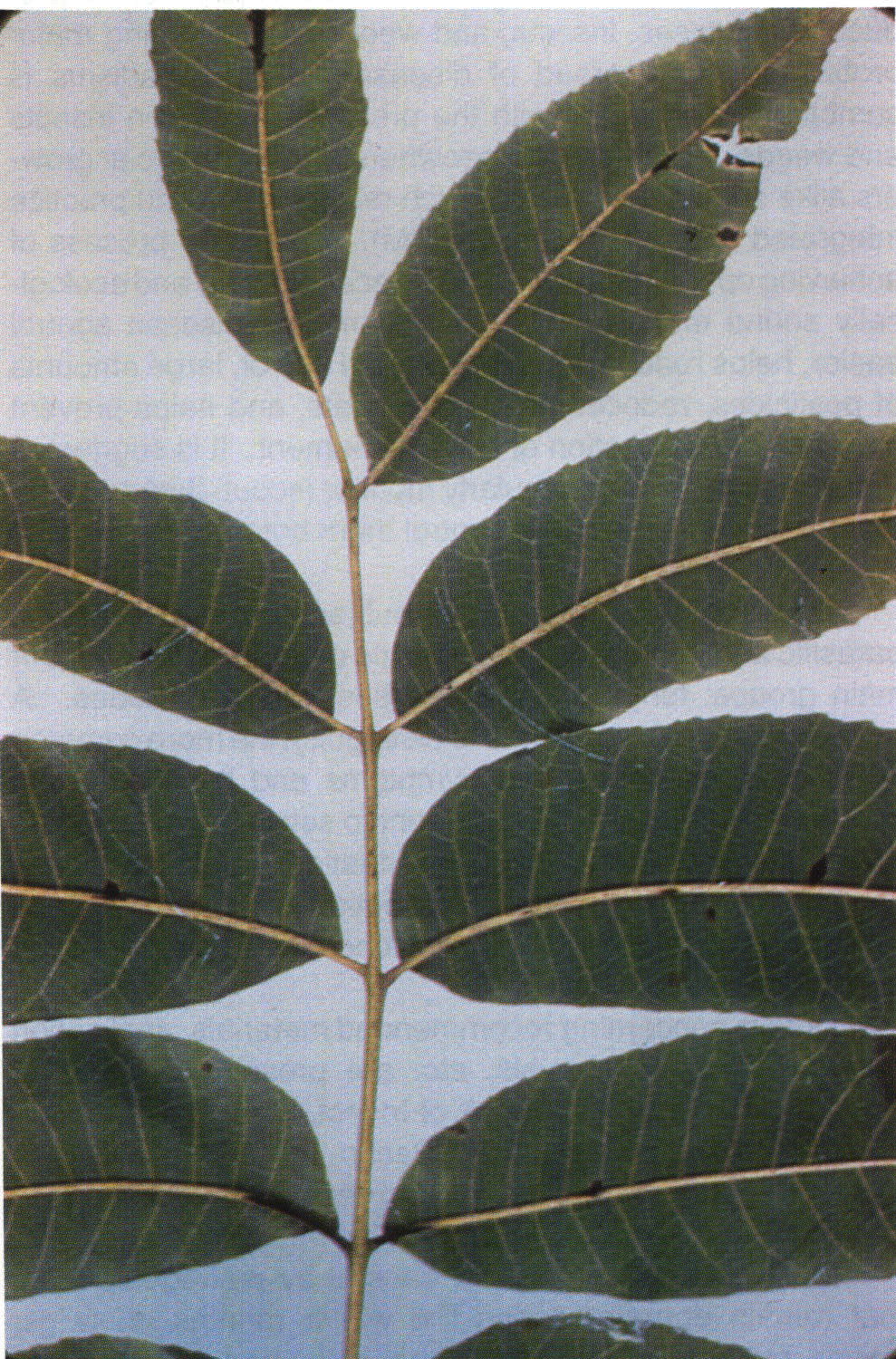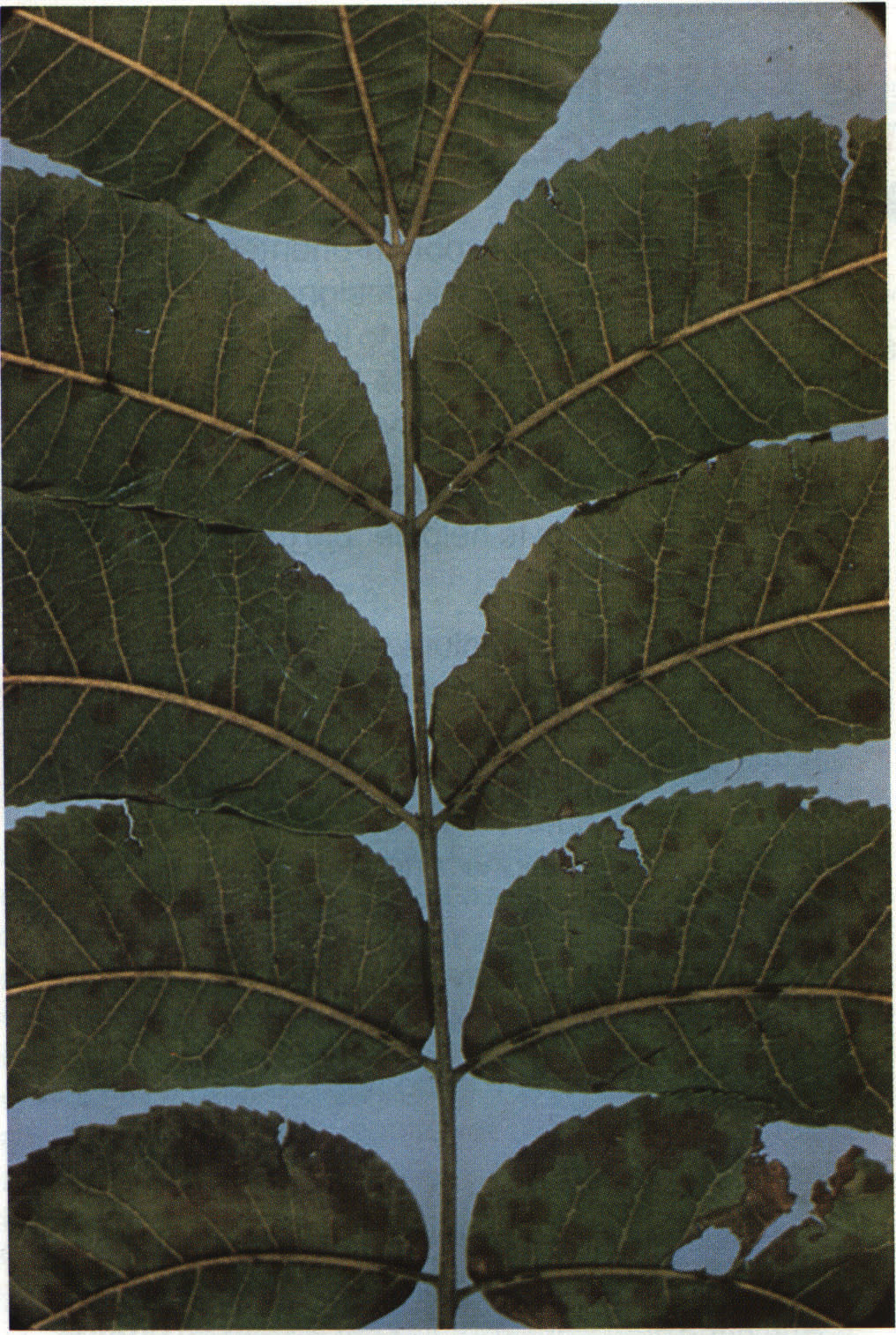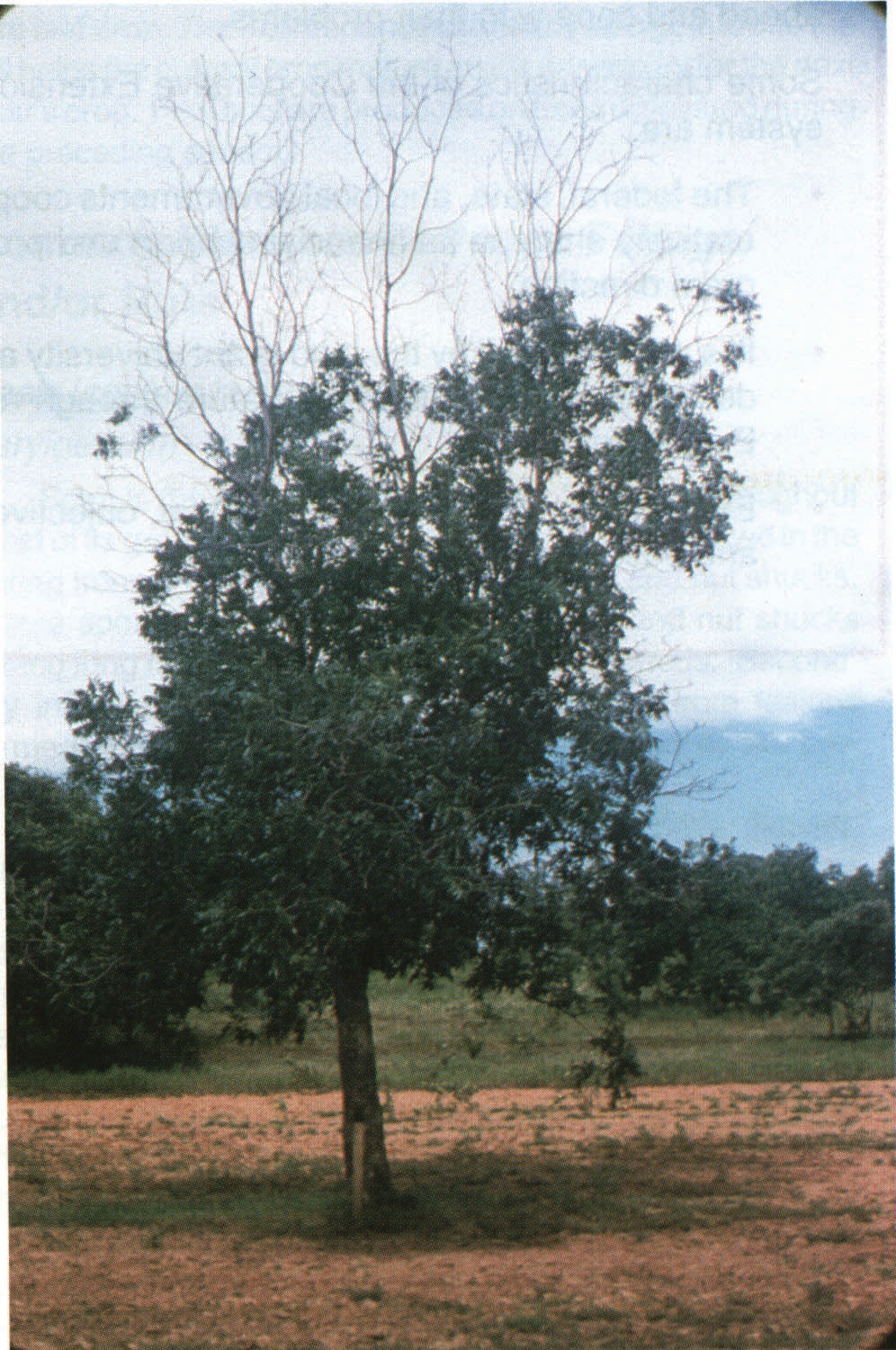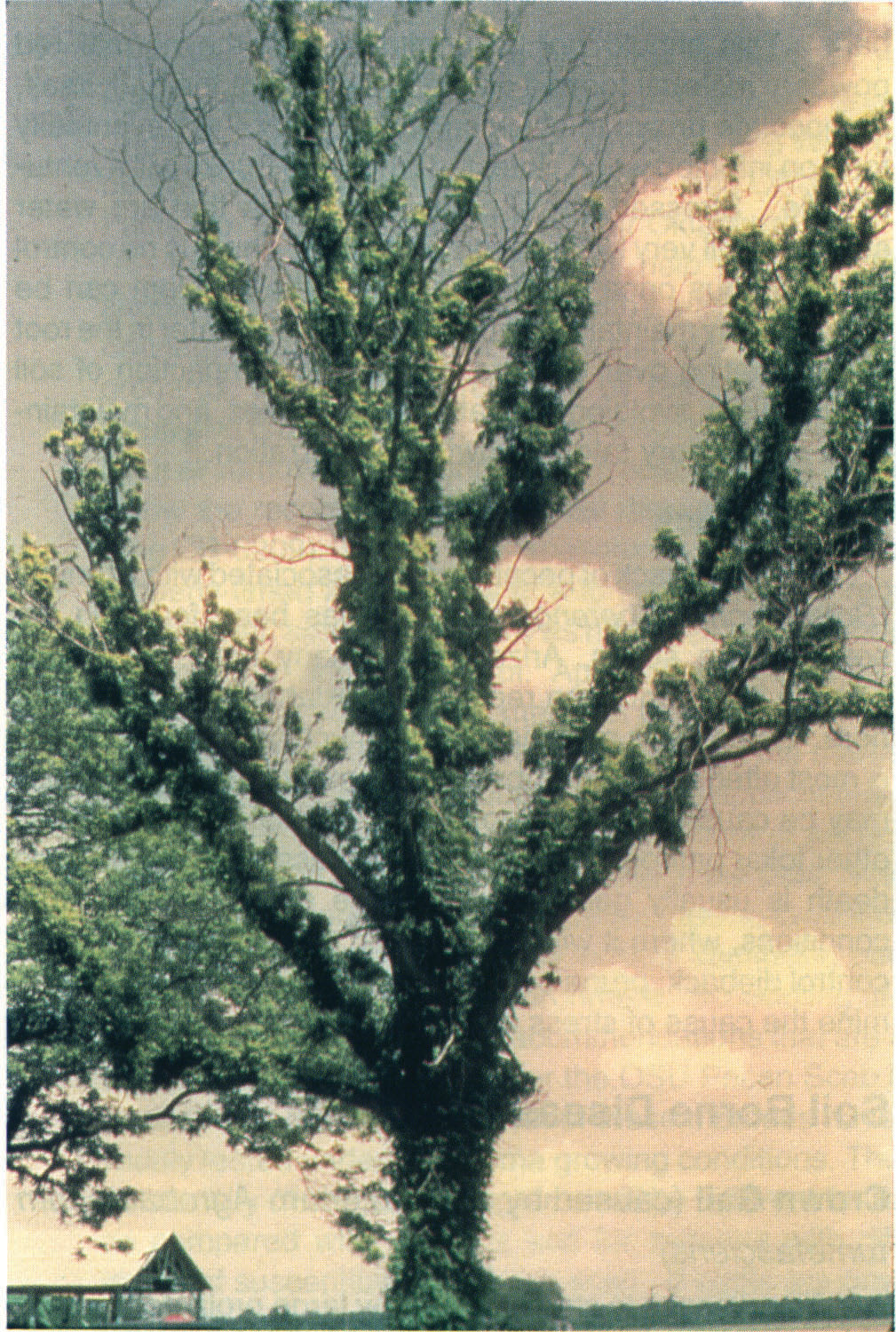Pecan Diseases: Prevention and Control
Pecan trees are increasingly being grown commercially and in home yards for nuts or
shade. With increased acreages of pecans in commercial production, diseases, insects,
and weeds are becoming major problems. The spread of disease-causing organisms is
sometimes associated with the presence of certain insects and weeds. Therefore, homeowners
and commercial growers alike should be aware of such relationships and practice integrated
pest management (IPM). IPM is the process of achieving optimal pest control in an
economically and ecologically sound manner. Use of IPM makes disease control easier,
helps reduce the need for, and use of, large amounts of pesticides, reduces production
costs, and helps prevent chemical contamination of the environment. It is suggested
that all pecan growers regularly monitor (scout) their trees for the presence of pests
and control them before they become major problems.
Pecan foliage and nuts are subject to many parasitic and non-parasitic diseases. Parasitic
organisms fall into four main groups: fungi, bacteria, viruses, and nematodes. A pecan
grower should be able to distinguish the more common types of diseases by their symptoms
and have sufficient knowledge of disease development to select the appropriate control
practices for the particular situation. Effective disease control means carrying out
a prevention program along with recommended disease-controlling chemicals to protect
trees from diseases, if needed.
Details concerning recommended materials, application rates, application intervals,
etc. are presented in E-832, Extension Agents’ Handbook of Insect, Plant Disease,
and Weed Control or CR-6209, Pecan Insect and Disease Control. These reports are revised
yearly to reflect changes in recommended materials, application rates, schedules,
etc.
Most pecan diseases are caused by pathogenic fungi that remain dormant during the
winter months on twigs, leaves, nut shucks, and bark, either in the tree or on the
soil. In early spring, under warm humid conditions, the fungi begin active growth
and produce conidia (spores) that are disseminated to growing tissues by wind, rain,
and insects. New infections produce lesions which become the source of succeeding
cycles of sporulation. The very best means of control is the use of resistant cultivars
(varieties). A fungicide spray program has to be followed for many cultivars and for
some native trees throughout the spring and summer. Early sprays are very important
to protect the current season’s crop, but the later sprays protect against late-season
diseases and premature leaf drop. The maintenance of healthy foliage late into the
fall helps the current crop mature and is necessary for the next year’s crop. Few
nuts are produced on trees defoliated during the preceding season.
Common Diseases of Pecan Foliage and/or Nuts
Scab (caused by the fungus Cladosporium caryigenum)
Scab is the most serious disease of pecans throughout most of its growing range. Primary
spores are produced in the spring from overwintering stromata on twigs and nut shucks.
These spores germinate on leaflets, twigs, and nut shucks during long rainy periods
or extended dew periods. Secondary infections occur as spores are released from lesions
formed during early infections. Secondary spores are produced throughout the summer.
The disease is characterized by small, dark, circular, olive to black spots on foliage
and nuts. These spots may fuse to form large blackened areas (Figure 1). If the disease
is not controlled, entire crops from more susceptible cultivars and some native and
seedling trees may be lost during periods of frequent rains or extended dew. The pink
mold fungus, Cephalothecium roseum, invades old scab lesions on nut shucks (Figure
1). If it invades the nut kernel, it can cause off flavors and pink rot. The shells
of infected nuts may have an oily appearance.
Pecan scab is readily controlled with properly applied sprays of effective recommended
fungicides, in conjunction with strict adherence to recommended sanitary practices,
or by use of resistant cultivars.
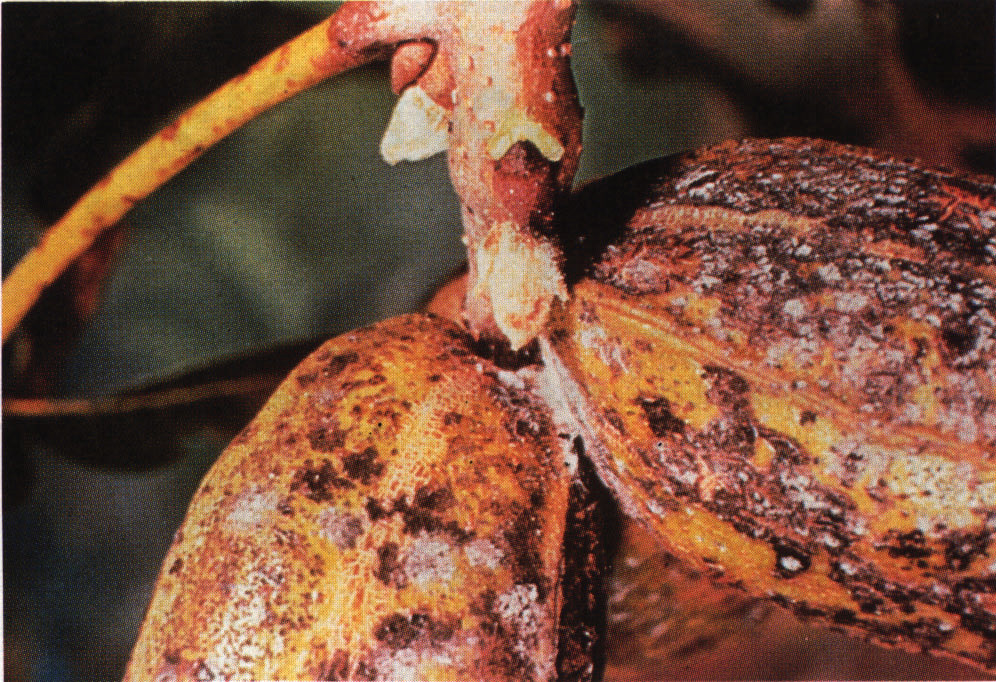
Figure 1. Scab lesions on shuck of a pecan nut. The pink mold fungus is growing in some lesions.
When one wishes to start a new orchard, it is advisable to plant tolerant or resistant
cultivars such as Chickasaw, Choctaw, Gormley, Graking, Mohawk, Mount, Oakla, Stuart,
and Peruque. Cultivars which should not be planted in much of the state, unless one
is prepared to follow a scab control program, include Apachee, Burkett, Caddo, Cherokee,
Chey-enne, Cowley, Desirable, Green River, Hayes, Mahan, Maramec, San Saba Improved,
Schley, Shawnee, Shoshoni, Sioux, Squirrel, Tejas, Western, and Wichita. For detailed
information on pecan cultivars, see OSU Extension Facts No. 6201, Pecan Varieties
for Oklahoma.
Various sanitary practices will help reduce scab and should be followed in conjunction
with a spray program. Keep drainage channels open so that water moves quickly out
of orchards. Improve air circulation by removing low-hanging limbs and crowded trees.
This will also help increase yields. Burn all removed limbs and trees. If scab remains
a problem, follow the recommended chemical disease control program (see CR-6209).
During “dry” seasons as few as two or three properly-timed applications of a fungicide
may be required. During “wet” seasons as many as six applications may be necessary
to achieve control. Applications should be made just before, or very shortly after,
wet periods.
With more effective, safer fungicides on the market and better information on scheduling
fungicide applications, making decisions about using fungicides to control pecan scab
does not have to be as difficult as it was in the past. We have an arsenal of fungicides
that can be counted on to control scab when used correctly and wisely without sacrificing
personal safety, food safety, or the environment. Scheduling of applications can be
made using recommendations that are keyed to plant development stages or the OSU Pecan
Scab Model available on the Internet. Both of these methods have been widely tested
under Oklahoma growing conditions. The level of intensity of fungicide programs will
be different for natives as compared with cultivars and for cultivars with different
levels of susceptibility to pecan scab. If cattle are grazed in native groves, decisions
will have to made that are best for overall production and profit of that farm unit.
Considering the low profit margin for native pecans, some growers may not be convinced
that the cost of a fungicide program is a sound investment for natives. If scab fungicides
are applied to natives when they are not needed or when there is not a nut crop to
protect, the investment is certainly unsound. But it is an equally unsound decision
not to apply fungicides to natives when they are needed.
Scheduling of fungicide applications using the phenological method. There are two
basic methods for deciding when to apply scab fungicides. The first, the phenological
method, is based on the plant growth stages or phenology of pecans and is weighted
heavily toward protecting the nut crop by preventing disease on nut shucks. The phenological
method covers the critical periods of pecan crop development. It errs on the side
of safety and may result in an application being made that is unnecessary. For natives
and more resistant cultivars a maximum of three applications are applied. The initial
application is made at the same time as the first pecan nut casebearer application,
and for natives this means that the decision to apply fungicide can be made once it
is certain that a good nut crop has set. A first cover application is made two to
three weeks after that and is followed by a second cover application two to three
weeks later. With this method a fourth application is needed for moderately to highly
susceptible cultivars at the pre-pollination stage about five weeks after bud break.
Scheduling of fungicide applications using the OSU Pecan Scab Model. The second method
of scheduling fungicide applications is to use the OSU Pecan Scab Model accessible
on the Internet at www.entoplp.okstate.edu/ under ‘Agricultural Models.’ This method
is based on the accrual of hours of actual weather conditions shown by research to
be favorable for scab disease. Use of the OSU Pecan Scab Model does require access
to the Internet. The model calculates the number of hours with relative humidity greater
than 90 percent and temperature greater than 70 F (= scab hours) using data from the
closest local Oklahoma Mesonet weather station. Users select the nearest weather station
by clicking on an interactive map. Thresholds of accumulated scab hours in the last
14 unprotected days have been established for native pecans and mostly resistant cultivars
(30 scab hours), moderately susceptible (20 scab hours), and highly susceptible (10
scab hours) cultivars. The web site not only gives the local accumulation of scab
hours for the last 28 days but it also links to information on the rates of scab fungicides
to use and the susceptibility of pecan cultivars. The model is most useful for taking
the risk out of timing fungicides for moderately to highly susceptible cultivars.
Protection is assured and applications are only made when needed. Experienced growers
will be able to use the web site to obtain the daily accumulated scab hours and this
should allow them to modify the phenological method to their advantage.
Vein Spot (caused by the fungus Gnomonia nerviseda)
Vein spot is a common disease of pecan leaves. It does not occur on shoots or nuts. Vein spot infections (lesions) are very similar to those caused by the scab fungus. Vein spot lesions, however, tend to be linear rather than round and also tend to be restricted to veins (Figure 2). In Oklahoma, this disease is usually not serious and is easily controlled by most scab control fungicides. Triphenyl tin formulations, however, are not very effective.
Figure 2. Vein spot symptoms on an infected pecan leaflet.
Liver Spot (caused by the fungus Gnomonia caryae var. pecanae)
Liver spot is characterized by the appearance of reddish brown (liver colored) circular spots one-eighth to five-eighths inch in diameter on the lower side of leaflets (Figure 3). In the fall, the spots turn cinnamon brown and contain small, dark fungal-fruiting bodies. This disease sometimes causes defoliation in the more humid southeastern states but is not considered a serious disease in Oklahoma. A scab control program controls this disease.
Figure 3. Liver spot symptoms on an infected pecan leaflet.
Powdery Mildew (caused by the fungus Microsphaera alni)
Powdery mildew occurs sporadically in Oklahoma and rarely is a serious disease in the state. It occurs on foliage and nuts alike and appears as a superficial powdery white growth (Figure 4). Early-infected nuts may remain small and have an early shuck split and shriveled kernels. In some other states, it sometimes causes defoliation. The disease is usually held in check when a scab control program is followed.
Figure 4. Powdery mildew symptoms on infected nut shucks.
Rosette (caused by zinc deficiency)
Zinc deficiency is usually caused by the unavailability of zinc from alkaline soils or low zinc soils. Zinc deficiency starts as a yellowing of the leaves. If not corrected, the leaves will become twisted, and later they will turn reddish brown (Figure 5). Twigs and small limbs will die, often beginning in the tops of affected trees (Figure 6). Large limbs will die, and eventually the tree will die. Treatment to correct this problem consists of applying a zinc chelate formulation or zinc sulfate to the soil or by spraying these and other materials like NZN, NZS, etc., onto the foliage. Spraying provides a quicker response and requires less material. Application recommendations are presented in OSU Extension Fact Sheet HLA-6232, Fertilizing Pecan and Fruit Trees.
Figure 5. Early symptoms of zinc deficiency (rosette) of pecan leaflets.
Figure 6. Death of branches of a pecan tree because of a long-term zinc deficiency.
Bunch Disease (caused by a Phytoplasma)
The characteristic symptom of bunch disease is bushy growths of slender willowy shoots,
resulting from an abnormal forcing of lateral buds (Figure 7). Symptoms may appear
on only one branch or on many branches. Bunch disease is very conspicuous in the spring
and early summer because the diseased shoots leaf out earlier than noninfected shoots.
It is believed that the pathogen is insect transmitted, probably by leafhoppers.
Severely-infected trees should be destroyed. If only a few branches are infected,
they should be removed much beyond the infected area. Some varieties are more resistant
than others and they may be successfully topworked onto susceptible trees.
Figure 7. Symptoms of bunch disease of pecan trees.
Trunk and Limb Diseases
Hypoxylon Canker
Hypoxylon canker of pecan is caused by a fungus (Hypoxylon atropunctatum). The fungus commonly occurs on oaks, it has recently been found on pecans in Oklahoma. The disease is characterized by sloughing off of bark and a reddish powdery substance formed on the wood under the bark. The disease is characterized by sloughing off of bark and a reddish powdery substance formed on the wood under the bark. This should not be confused with the normal red powdery material formed on the underside of the bark itself. A chocolate brown to black crusty substance will eventually form on infected wood. Infected limbs and trunks will eventually die. Stressed trees, particularly those that are water stressed, will very likely become infected. There is no control of the fungus once it infects a tree. The problem can be prevented by maintaining a proper balance of water in the root zone, painting over wounds, preventing compaction of soil around trees, avoiding cultivation around trees, and maintaining a satisfactory rate of growth by fertilization.
Twig Dieback
A twig dieback of pecan trees is associated with a fungus (Botryosphaeria berengeriana). It has been found in the southeastern states, Arizona and many areas of Texas. Though it has not been reported in Oklahoma, it may occur here. Some limbs may die back as much as 24 to 30 inches. It is most often found on limbs that are under stress. The stress may be caused by over-production, defoliation by scab and other foliar pathogens, drought, or excessive shading. Twig death is usually general over a tree except under shady conditions, where it will occur only in the shaded areas. To control dieback, prune out dead wood and destroy it. Determine the cause of stress and, if possible, correct it.
Soil Borne Diseases
Crown Gall (caused by the bacterium Agrobacterium tumefasciens)
The disease is characterized by large proliferating galls on the roots and bases of
the trunk of infected trees (Figure 8). Infected nursery trees should be burned. Do
not plant infected trees or plant trees in an area known to be infested, as this practice
can spread the causal bacteria. This pathogen infects a wide range of plants.
Figure 8. Galls on roots of a pecan tree caused by the crown gall bacterium.
Nematode Diseases
Pathogenic root-knot nematodes (Meloidogyne spp.) invade small roots of the pecan tree and cause small galls to form on the roots. Pecan roots are also susceptible to infection by a ring nematode (Criconomella rusium). Infected nursery trees should not be planted in an orchard. They should be destroyed. Infected trees sometimes show stunting and resetting of the foliage, which applications of zinc compounds and fertilizers will not correct. Use the same control measures as described for the crown gall disease described above. These nematodes have a wide host range and should not be introduced and spread.
Phil Mulder
Department Head, Entomology and Plant Pathology

